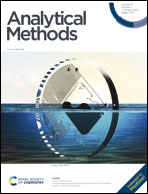An electrochemical sensor based on a Co3O4–ERGO nanocomposite modified screen-printed electrode for detection of uric acid in artificial saliva†
Abstract
In this study, we report the fabrication of a nanocomposite consisting of Co3O4 nanoparticles (Co3O4 NPs) and electrochemically reduced graphene oxide (ERGO) on a screen-printed electrode (SPE) and its sensing performance in the electrochemical detection of uric acid (UA). The surface modification of the electrode was confirmed by using a variety of characterization techniques (FE-SEM, XRD, AFM, EDX, WCA, FTIR, and Raman spectroscopy). In addition, the surface modification was electrochemically characterized step by step through CV, EIS and DPV techniques, and the results showed that the Co3O4–ERGO nanocomposite exhibited highly sensitive and selective sensing performance towards the oxidation of UA in 0.1 M (pH 7.0) phosphate buffer solution (PBS). The sensor (Co3O4–ERGO/SPE) signals were observed to be linear to the UA concentration in the range of 5 μM to 500 μM (R2 = 0.9985). After revealing its other performance characteristics, such as repeatability, reproducibility, stability, sensitivity, and selectivity, the sensor was successfully applied to the analysis of UA in artificial saliva samples.



 Please wait while we load your content...
Please wait while we load your content...